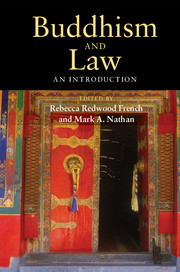Book contents
- Frontmatter
- Dedication
- Contents
- Maps and Illustrations
- Contributors
- Preface
- Abbreviations
- Introducing Buddhism and Law
- Part I The Roots of Buddhism and Law in India
- Part II Buddhism and Law in South and Southeast Asia
- 6 Buddhism and Law in Sri Lanka
- 7 Flanked by Images of Our Buddha
- 8 The Legal Regulation of Buddhism in Contemporary Sri Lanka
- 9 Pāli Buddhist Law in Southeast Asia
- 10 Genres and Jurisdictions
- Part III Buddhism and Law in East Asia
- Part IV Buddhism and Law in North Asia and the Himalayan Region
- A Selection of Readings
- Index
- References
9 - Pāli Buddhist Law in Southeast Asia
Published online by Cambridge University Press: 05 August 2014
- Frontmatter
- Dedication
- Contents
- Maps and Illustrations
- Contributors
- Preface
- Abbreviations
- Introducing Buddhism and Law
- Part I The Roots of Buddhism and Law in India
- Part II Buddhism and Law in South and Southeast Asia
- 6 Buddhism and Law in Sri Lanka
- 7 Flanked by Images of Our Buddha
- 8 The Legal Regulation of Buddhism in Contemporary Sri Lanka
- 9 Pāli Buddhist Law in Southeast Asia
- 10 Genres and Jurisdictions
- Part III Buddhism and Law in East Asia
- Part IV Buddhism and Law in North Asia and the Himalayan Region
- A Selection of Readings
- Index
- References
Summary
Introduction
My title contains an inexactitude and a neologism. The Pāli Buddhist legal tradition’s habitat is a lot narrower than the geographic label “Southeast Asia” suggests. Few Buddhists live in the Southeast Asian archipelago. To speak of “Mainland Southeast Asia” as the land of Pāli Buddhism is also inexact, for on the eastern (Vietnamese) side of the subcontinent, Buddhists adhere to the Chinese tradition. It is better, then, to refer to the habitat of Pāli Buddhism as “Laos, Cambodia, Thailand, and Burma, along with the adjoining parts of China, Malaysia and Bangladesh.” However, even this unwieldy toponym requires further clarification. Pāli Buddhists prefer to live in the plains and valleys, where they invest heavily in building dams, canals, monasteries, and pagodas. Above them, in the foothills of the Central Asian massif, is a different ecology, suited to swidden cultivation of millet and dry-rice This is where the montagnards live, scratching their sustenance from fields that soon lose their nutrients. These mountain people invest little in infrastructure, since every few years they have to move their villages and fields. They have resisted conversion to Buddhism, despite centuries of missionary work.
It is difficult to pin down a belief system onto a set of global positioning service coordinates. My best endeavor is this: The Pāli Buddhist tradition flourishes in west and central mainland Southeast Asia in those valleys and plains where wet rice can be grown. I propose the neologism “Paliland” as shorthand for this region. Buddhists are “Pāli” if the scriptures they regard as normative are written in the Prakrit language called (by them) “Magadhan” and (by others) “Pāli.” Some prefer the label Theravāda (meaning “the Path of the Elders”), others Hīnayāna (meaning “the Lesser Vehicle”).
- Type
- Chapter
- Information
- Buddhism and LawAn Introduction, pp. 167 - 182Publisher: Cambridge University PressPrint publication year: 2014
References
- 1
- Cited by



